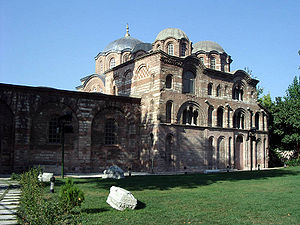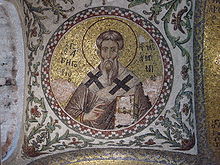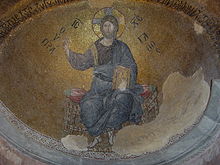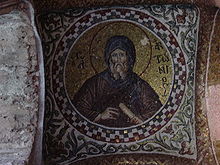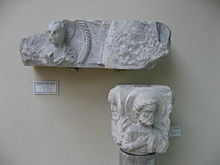- Pammakaristos Church
-
"Fethiye Mosque" redirects here. For other uses, see Fethiye Mosque (disambiguation).
Coordinates: 41°01′45″N 28°56′47″E / 41.02917°N 28.94639°E
Pammakaristos Church, also known as the Church of Theotokos Pammakaristos (Greek: Θεοτόκος ἡ Παμμακάριστος, "All-Blessed Mother of God"), in 1591 converted into a mosque and known as Fethiye Mosque (Turkish: Fethiye Camii, "mosque of the conquest") and today partly a museum, is one of the most famous Byzantine churches in Istanbul, Turkey. The parekklesion, besides being one of the most important examples of Constantinople's Palaiologan architecture, has the largest amount of Byzantine mosaics in Istanbul after the Hagia Sophia and Chora Church.
Contents
Location
The building is located in the Çarşamba neighbourhood within the district of Fatih inside the walled city of Istanbul. Theotokos Pammakaristos overlooks the Golden Horn.
History
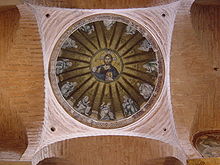 View of the central dome of the parekklesion with Christ Pantocrator surrounded by the prophets of the Old Testament
View of the central dome of the parekklesion with Christ Pantocrator surrounded by the prophets of the Old Testament
According to most scholars, the church was built between the eleventh and the twelfth centuries. Many historians and archaeologists believe that the original structure of the church can be attributed to Michael VII Ducas (1071–1078), others put its foundation in the Comnenian period.[1] It has also been suggested by the Swiss scholar and Byzantinist Ernest Mamboury that the original building was erected in the 8th century.[2]
A parekklesion (a side chapel) was added to the south side of the church in the early Palaiologan period, and dedicated to Christos ho Logos (Greek: Christ the Word).[3] The small shrine was erected by Martha Glabas in memory of her late husband, the protostrator Michael Doukas Glabas Tarchaneiotes, a general of Andronikos II Palaiologos, shortly after the year 1310.[4] An elegant dedicatory inscription to Christ, written by the poet Manuel Philes, runs along the parekklesion, both outside and inside it.
The main church was also renovated at the same time, as the study of the Templon has shown.[4] Following the fall of Constantinople, the seat of the Greek Orthodox Patriarchate was first moved to the Church of the Holy Apostles, and in 1456 to the Pammakaristos Church, which remained as the seat of the Patriarchate until 1587.
Five years later, the Ottoman Sultan Murad III converted the church into a mosque and renamed it in honor of his Fetih (Conquest) of Georgia and Azerbaijan, hence the name Fethiye Camii. To accommodate the requirements of prayer, most of the interior walls were removed in order to create a larger inner space.
The complex, which was neglected, has been restored in 1949 by the Byzantine Institute of America and Dumbarton Oaks, which brought it back to its pristine splendor.[1] While the main building remains a mosque, the parekklesion has since then been a museum.[5]
Architecture and decoration
The Comnenian building was a church with a main aisle and two deambulatoria,[6] and had three apses, and a narthex to the west. The masonry was typical of the Comnenian period, and adopted the technique of the recessed brick. In this technique, alternate coarses of brick are mounted behind the line of the wall, and are plunged in a mortar's bed, which can still be seen in the cistern underneath and in the church.[1] The transformation of the church into a mosque changed the original building greatly. The arcades connecting the main aisle with the deambulatoria were removed and were replaced with broad archways to open up the nave. The three apses were removed too. In their place toward the east a great domed room was built, obliquely with respect to the orientation of the building.
On the other side, the parekklesion represents the most beautiful building of the late Byzantine period in Constantinople. It has the typical cross-in-square plan with five domes, but the proportion between vertical and horizontal dimensions is much bigger than usual (although not so big as in the contemporary Byzantine churches built in the Balkans).
Although the inner colored marble revetment largely disappeared, the shrine still contains the restored remains of a number of mosaic panels, which, while not as varied and well-preserved as those of the Chora Church, serve as another resource for understanding late Byzantine art.
A representation of the Pantocrator, surrounded by the prophets of the Old Testament (Moses, Jeremiah, Zephaniah, Micah, Joel, Zechariah, Obadiah, Habakkuk, Jonah, Malachi, Ezekiel, and Isaiah) is under the main dome. On the apse, Christ Hyperagathos is shown with Virgin Mary and St. John the Baptist. The Baptism of Christ survives intact to the right side of the dome.
Notes
- ^ a b c Mathews (1976), p. 346
- ^ Mamboury, (1933)
- ^ Mathews (1976), p. 347. Logos in the Eastern Orthodox Theology is the denomination of the second Person of the Trinity
- ^ a b Mathews (1976), p. 347.
- ^ Entrance tickets, which up to some months ago had to be bought at Haghia Sophia, are now for sale at the parekklesion.
- ^ A deambulatorium is an aisle which encircles the central part of a church
References
- Mamboury, Ernest (1933) (in French). Byzance - Constantinople - Istanbul (3 ed.). Istanbul: Milli Neşriyat Yurdu.
- Mathews, Thomas F. (1976). The Byzantine Churches of Istanbul: A Photographic Survey. University Park: Pennsylvania State University Press. ISBN 0-271-01210-2.
- Belting, Hans; Mouriki, Doula; Mango, Cyril (1978). Mosaics and Frescoes of St Mary Pammakaristos (Fethiye Cami Istanbul). Dumbarton Oaks Pub Service. ISBN 0884020754.
- Harris, Jonathan (2007). Constantinople: Capital of Byzantium. Hambledon/Continuum. ISBN 978 1847251794.
External links
 Media related to Pammakaristos Church at Wikimedia Commons
Media related to Pammakaristos Church at Wikimedia CommonsTopics on the Byzantine Empire History Roman Empire → Dominate → Early Byzantine period (Constantinian dynasty → Valentinian dynasty → Theodosian dynasty → Leonid dynasty → Justinian dynasty → Heraclian dynasty) → Middle Byzantine period (Isaurian dynasty → Amorian dynasty → Macedonian dynasty → Doukid dynasty → Komnenian dynasty → Angelid dynasty) → Late Byzantine period (Fourth Crusade → Latin Empire, Empire of Nicaea, Epirus, Trebizond, and other successor states) → Palaiologan dynasty → Fall to the Ottoman Empire)Government and
AdministrationCentral government: Emperors (Basileus) · Senate · Imperial Bureaucracy · Eparch · Early period (Praetorian prefects · Magister officiorum · Comes sacrarum largitionum · Quaestor sacri palatii) · Middle period (Logothetes · Sakellarios) · Late Byzantine period (Megas logothetes · Mesazon)
Provincial administration: Early period (Praetorian prefectures · Dioceses · Provinces · Exarchate of Ravenna · Exarchate of Africa) · Middle period (Themes · Kleisourai · Catepanates) · Late period (Kephale · Despotates)
Diplomacy: Treaties · DiplomatsLaw Military Byzantine army (Late Roman army → East Roman army → Middle Byzantine army → Komnenian army → Palaiologan army): Battle tactics · Military manuals · Wars and Battles · Revolts · Siege warfare · Generals · Foederati · Bucellarii · Tagmata · Domestic of the Schools · Mercenaries · Varangian Guard · Akritai · Pronoia
Byzantine navy: Karabisianoi · Maritime themes (Cibyrrhaeots · Aegean Sea · Samos) · Dromon · Greek fire · Megas doux · Admirals · Naval battlesReligion and Church Eastern Orthodox Church · Ecumenical councils · Patriarchate of Constantinople · Arianism · Monophysitism · Paulicianism · Iconoclasm · Great Schism · Bogomilism · Hesychasm · Mount Athos · Jews · MuslimsSociety and Culture Architecture: Secular · Sacred (Cross-in-square) · Constantinople (Great Palace of Constantinople · Blachernae Palace · Hagia Sophia · Hagia Irene · Chora Church · Pammakaristos Church · City Walls) · Thessalonica (Arch of Galerius and Rotunda · Hagios Demetrios · Hagia Sophia · Panagia Chalkeon) · Ravenna (San Vitale · Sant'Apollinare in Classe · Sant'Apollinare Nuovo) · Daphni Monastery · Hosios Loukas · Nea Moni of Chios · Saint Catherine's Monastery, Mount Sinai · Mystras · Revival
Art: Icons · Mosaics · Painters · Macedonian period art · Komnenian renaissance
Economy: Agriculture · Coinage and Mints · Trade (Silk · Silk Road · Trade with the Varangians)
Literature: Novel · Acritic songs (Digenes Akritas) · Alexander romance · Historians
People and everyday life: People · Byzantine Greeks · Heraldry · Hippodrome · Calendar · Cuisine · Dance · Dress · Music
Science and learning: Inventions · Medicine · Neoplatonism · Philosophy · Encyclopaedism · Scholars in the Renaissance · Scholars · UniversityLegacy/Other topics Byzantine Empire Portal Categories:- Mosques converted from churches in Istanbul
- Churches in Istanbul
- Museums in Istanbul
- 1310s architecture
- Byzantine sacred architecture
- Byzantine art
- Constantinople
- Fatih, Istanbul
- Ecumenical Patriarchate of Constantinople
- Architecture in Turkey
Wikimedia Foundation. 2010.

